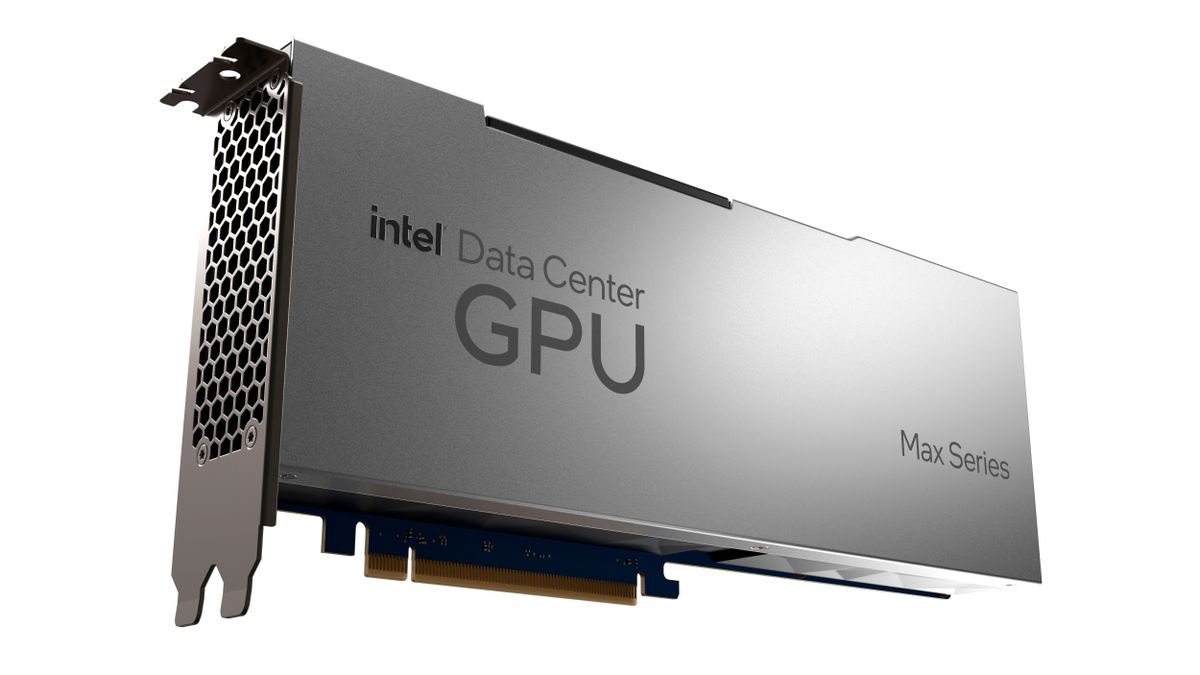Intel Axes Data Center GPU Max 1350, Preps New Max 1450 for ‘Different Markets’

Intel has effectively restructured the company’s Data Center GPU Max series of compute GPUs. The chipmaker confirmed to Tom’s Hardware that it has decided to eliminate the Data Center Max GPU 1350 from its product stack. However, it will introduce a newly-baked Data Center Max GPU 1450 later this year with cut-down I/O bandwidth to cater to ‘different markets.’ The move comes on the heels of Intel’s decision to cancel its Rialto Bridge GPUs in the wake of the restructuring of its AXG graphics division.
The initial Ponte Vecchio GPU lineup consisted of the Data Center Max GPU 1550, Data Center Max GPU 1350, and Data Center Max GPU 1100. Intel already launched the 1550 model in the first quarter of this year. The impending Q2 launch for the 1100 model still stands unaffected by the recent addition of the Data Center Max GPU 1450 to the product stack. However, Intel hasn’t provided a specific launch date for the Data Center Max GPU 1450 yet, though we do know it will arrive this year.
“We launched the Intel Data Center Max GPU 1550 (600W), which was initially targeted for liquid-cooled solutions only. We have since expanded our support by offering Intel Data Center Max GPU 1550 (600W) to include air-cooled solutions.
“As a result, we are streamlining our product offerings by removing the Intel Data Center Max GPU 1350 (450W), which was geared for air-cooled solutions. We will introduce the Data Center GPU Max 1450 SKU later in 2023, which has lower IO bandwidth for different markets and will be able to use air- and liquid-cooling solutions. Rounding out our product portfolio, we will introduce the Data Center GPU Max 1100 SKU, which is a 300W PCIe card (Gen5) for broad market deployments,” an Intel spokesperson told Tom’s Hardware.
| Header Cell – Column 0 | Data Center GPU Max 1100 | Data Center GPU Max 1350 | Data Center GPU Max 1450 | Data Center GPU Max 1550 |
|---|---|---|---|---|
| Form-Factor | PCIe | OAM | ? | OAM |
| Tiles + Memory | ? | ? | ? | 39 + 8 |
| Transistors | ? | ? | ? | 100 billion |
| Xe HPC Cores | Compute Units | 56 | 112 | ? | 128 |
| RT Cores | 56 | 112 | ? | 128 |
| 512-bit Vector Engines | 448 | 896 | ? | 1,024 |
| 4096-bit Matrix Engines | 448 | 896 | ? | 1,024 |
| Base Clock (MHz) | 1,000 | 750 | ? | 900 |
| Max Dynamic Clock (MHz) | 1,550 | 1,550 | ? | 1,600 |
| L1 Cache | 12MB | 48MB | ? | 64MB at 105 TB/s |
| L2 Rambo Cache | 108MB | 216MB | ? | 408MB at 13 TB/s |
| Memory | 48GB | 96GB | ? | 128GB at 3.2 TB/s |
| Memory Interface | 1024 bit | ? | ? | 1024 bit |
| Memory Bandwidth (GB/s) | 1,228.8 | ? | ? | 3276.8 |
| Multi-GPU IO | 8 | 16 | ? | 16 |
| TDP | 300W | 450W | ? | 600W |
Intel hasn’t yet shared the specifications for the Data Center GPU Max 1450. Nonetheless, logic implies it will be a cut-down version of the Data Center GPU Max 1550, but we haven’t yet confirmed. The Data Center GPU Max 1450 will support air- and liquid-cooling solutions, and we suspect it could carry the same 450W TDP rating as the canceled 1350 model. We’ve reached out to Intel for further confirmation.
One crucial detail from Intel’s statement is that the chipmaker has tailored the Data Center GPU Max 1450 for “different markets,” which we suspect pertains to China. According to Intel, the Data Center GPU Max 1450 will arrive with reduced I/O bandwidth levels, a move that, in all likelihood, is meant to comply with U.S. regulations on GPU exports to China.
Remember, US export rules now dictate that the chip-to-chip I/O bandwidth for China-bound GPUs must be less than 600 GB/s. For instance, Nvidia modified its H100 (Hopper) GPU and rebranded it to H800 to tailor it for the now-limited Chinese market. It’s reasonable to expect that the Data Center GPU Max 1450 could take a similar approach.
Besides replacing the Data Center Max GPU 1350, Intel also expanded the cooling options for the flagship Data Center Max GPU 1550. The 600W GPU was originally only available with liquid-cooled solutions. However, Intel will now offer air cooling on the Data Center Max GPU 1550.
Intel’s initial plan was to release Rialto Bridge to succeed Ponte Vecchio this year and launch Falcon Shores in 2024 to replace Rialto Bridge. However, the chipmaker has ultimately decided to jettison Rialto Bridge and push Falcon Shores to 2025. As a result, Intel will have to make do with Ponte Vecchio for at least another two years, competing against Nvidia’s H100 and AMD’s Instinct MI300.






